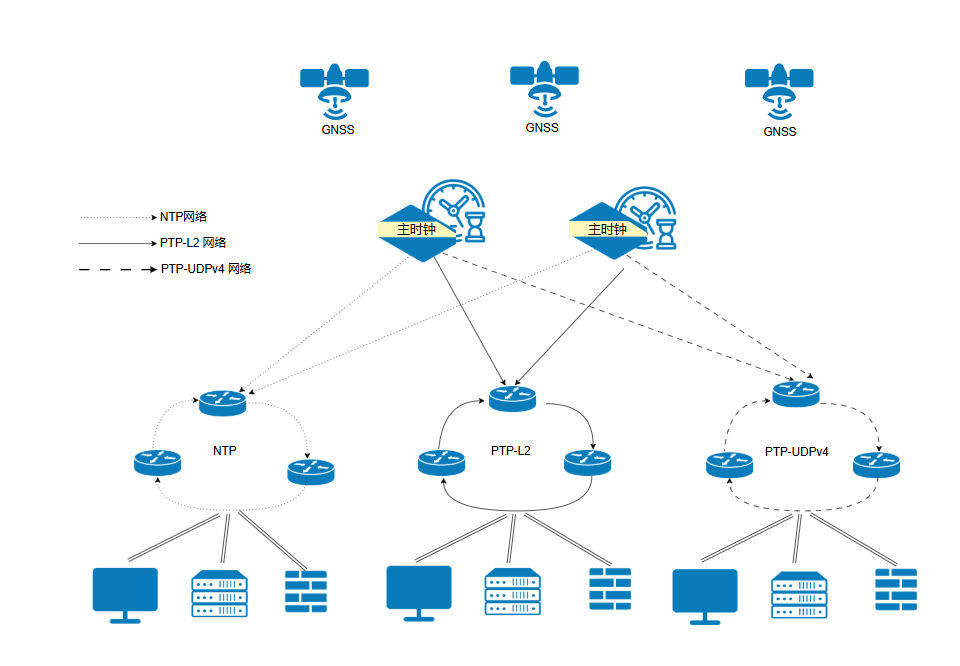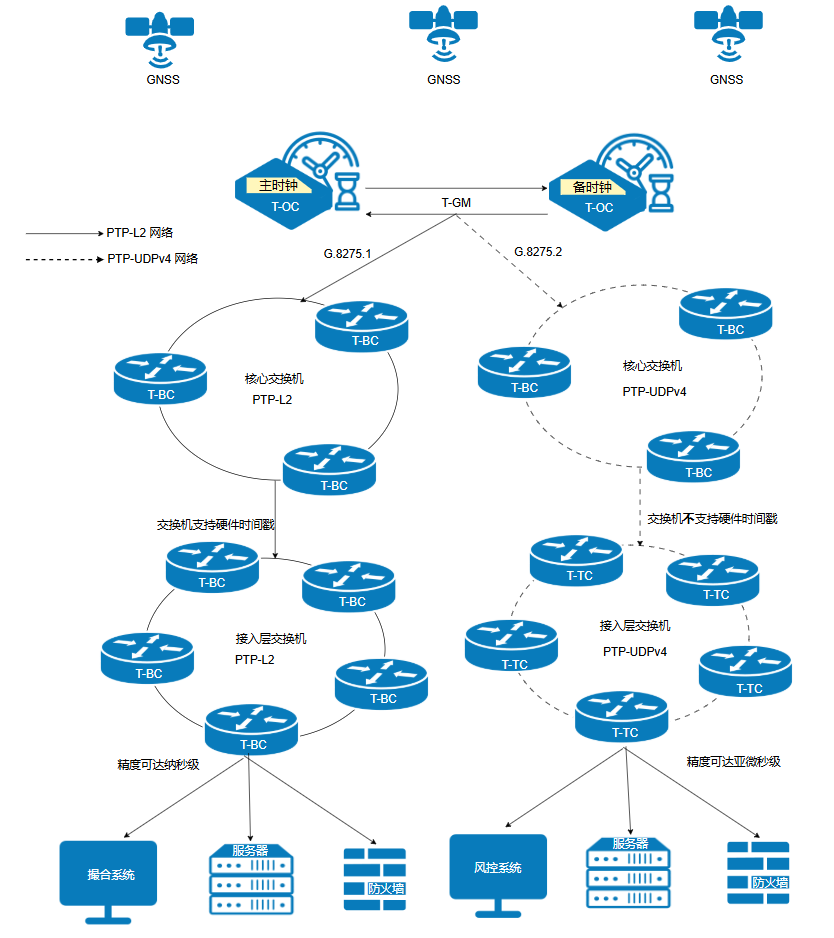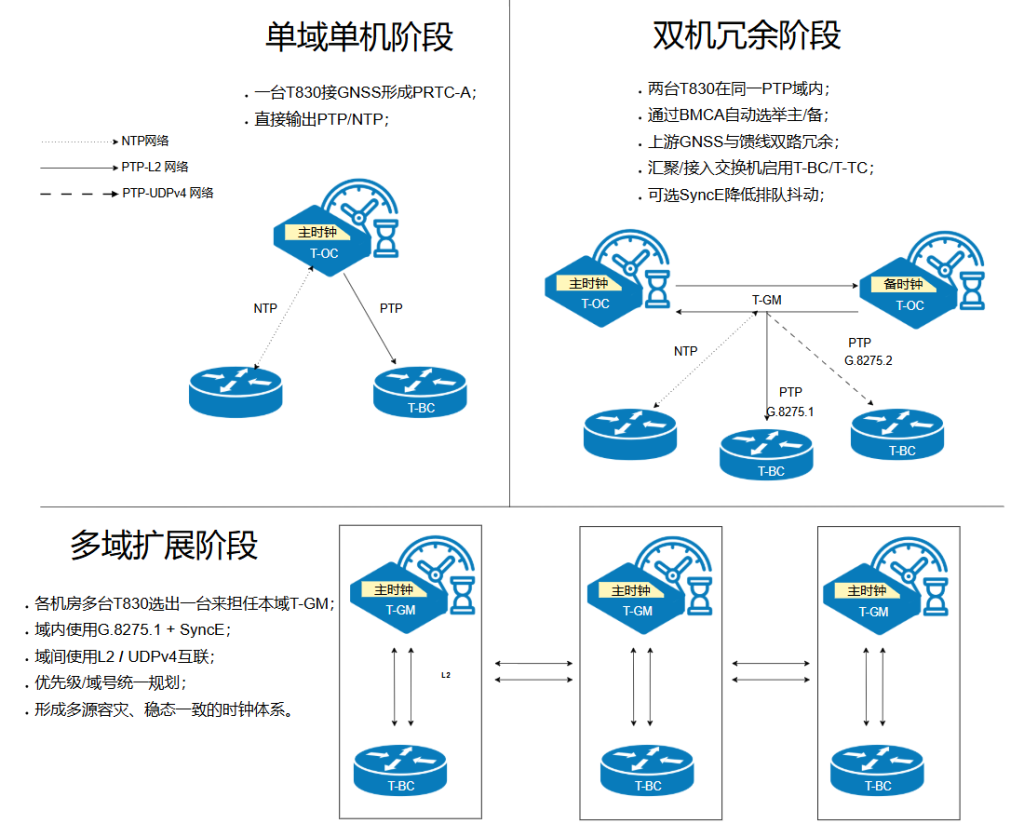T830 Unified Time Solution for the Financial Industry: Smooth Progression from NTP to PTP (IEEE 1588)
T830 Unified Time Solution for the Financial Industry: Smooth Progression from NTP to PTP (IEEE 1588)
Minimal transformation, first to reach the low microseconds, and then punch the sub-microseconds/hundred nanoseconds, to meet the transaction traceability and audit review ---- Financial Industry Clock Solution
One,summaries
In a financial production network, time is not "as close as possible", but "must be consistent and traceable". When relying only on NTP, queuing jitter and path asymmetry across three layers and congestion can magnify deviations and tail risks to the millisecond-microsecond scale; PTP transforms source-to-end errors from uncontrollable fluctuations to budgetable, attributable, and manageable ones through hardware timestamps on the NIC/switching chip, boundary/transparent clocks, and (optionally) SyncE. PTP turns "source-network" errors from uncontrollable fluctuations into budgetable, attributable, auditable quantities of work through hardware timestamps on the NIC/switch chip and (optional) SyncE. With the T830 as the core, without interrupting the NTP of the existing network, the critical links are stabilized to the low-microsecond level, and tightened to the sub-microsecond/hundred-nanosecond level in the controlled core segments to maximize verifiability and compliance certainty in exchange for the minimal modification.
Two,Pain Points and NTP's Realistic Ceiling
Summarization/strategy trading has zero tolerance for "sequential order", but NTP's software timestamps and path asymmetry make it difficult to constrain episodic peaks; market release/playback requires strict cross-system reproduction, but NTP's jitter and tail risk push up forensic costs; order/risk control relies on tight timing, but NTP's cross-domain drift is prone to triggering miscalculation and rollback; clearing/auditing requires "timestamp endorsement", but NTP lacks hardware-level corrections and a complete UTC traceability chain for each hop. While clearing/auditing requires "time-stamped endorsement", NTP lacks hardware-level corrections for each hop and a complete UTC traceability chain. Therefore, NTP is suitable for "basic availability", but has a natural upper limit on financial level consistency and auditability.
Three,Why PTP must be introduced
PTP eliminates host stack jitter with hardware timestamps, corrects residency delays with T-BC/T-TC, and harmonizes network frequencies with SyncE; prioritizes One-Step in controlled segments to reduce jitter, and Two-Step in restricted segments to ensure compatibility.
Four,Transitional thinking
General principle: PTP priority, NTP coexistence; with the premise of minimal modification of the existing network, T830 provides PTP and NTP at the same time, and can be smoothly switched at any stage.
Selection rules (a phrase to memorize): go L2 if you support L2; go UDPv4 if you don't support L2 but do support PTP; continue to go NTP if you only support NTP.
Option 1 (Hybrid Protocol Coexistence):
T830 Parallel output of PTP and NTP: Clients that support L2 go straight to L2 for lower jitter; clients that support PTP but not L2 go to UDPv4 (G.8275.2) to traverse Layer 3 and policy domains; NTP-only inventory devices continue to use NTP. network-side isolation is light with domain/priority + VLANs for low-disturbance uplinks and network-wide "alignment tightening". "Align first and tighten later".

Option 2 (Intra-domain L2 high precision + Inter-domain UDPv4 flexible interconnect):
L2 (G.8275.1 + SyncE) is adopted for the core segment of summarization/quotation, T-BC is enabled for core/aggregation, T-TC is enabled for access, and One-Step is given priority (or Two-Step is used if One-Step is not supported); cross server room/cross three-tier or heterogeneous segments are unified with UDPv4 (G.8275.2) articulation to form The steady-state goal of "sub-microsecond/hundred nanoseconds within the domain and low-microseconds between domains"; the two programs can be promoted in parallel: first, let the whole network "run up and be right", and then "pull the critical path full and be right more accurately". ".

Five,Architecture strategies (L2 vs UDPv4, One-Step vs Two-Step):
L2 vs. UDPv4 trade-offs: Controlled campus/co-locations prioritize L2 (G.8275.1 + SyncE) for best jitter and symmetry; cross-layer 3/cross-domain use UDPv4 (G.8275.2) for traversal of routes and security domains.
One-Step and Two-Step trade-offs: One-Step is used to support One-Step; Two-Step is used if One-Step is not supported. One-Step completes the alignment in a single frame, with lower jitter, but it has hardware requirements; Two-Step pairs two frames for better compatibility. At present, enterprises are mostly configured with Two-Step.

Campus/multi-computer room expansion (multiple × T830): multiple T830s in each computer room select one as the domain T-GM, intra-domain core segments using L2 (G.8275.1 + SyncE), inter-domain using UDPv4 (supports L2 priority configuration L2); domain number/prioritized scheduling of multi-source disaster recovery is consistent with the steady-state, and the deviation of the overall system can reach the target of "transaction nanoseconds + logging microseconds + office milliseconds". Transaction nanosecond level + log microsecond level + office millisecond level" target. Layering by business importance to meet the target.
In high-frequency aggregation and low-latency strategy trading, the unified UTC timestamp significantly reduces disputes over "who was first and who was last"; in market release and replay, the cross-system timeline is strictly aligned, making abnormal replay reproducible and explainable; in ordering and risk-control scenarios, the consistent timing reduces the cost of miscalculation and rollback; in clearing and auditing, the 'GNSS/PRTC→TGM→network (BC/TC)→host (T-TSC)' traceability chain allows each timestamp to have its provenance and be backed up. The traceability chain of 'GNSS/PRTC→T-GM→Network (BC/TC)→Host (T-TSC)' allows each timestamp to have a provenance and endorsement.
Six, Why T830 Clock Server
First of all, on the time source side, T830 clock server can be upgraded from PRTC-A to PRTC-B on demand, and reserve space for ePRTC evolution to extend the time keeping in GNSS disturbed scenarios; on the network side, T830 clock server supports L2 and UDPv4 two kinds of PTP images at the same time, which is naturally suitable for the hybrid scenario of "L2 for those who support L2, UDPv4 for those who don't; NTP for those who don't support PTP" that you proposed, and with T-BC/T-TC, SyncE, One-Step/Tep4 to continue to go NTP. The T830 clock server supports both L2 and UDPv4 PTP images, naturally adapting to the mixed scenario of "L2 for those who support L2 and UDPv4 for those who don't; NTP for those who don't support PTP" you proposed, and naturally synergizing with T-BC/T-TC, SyncE, and One-Step/Two-Step; on the terminal side, in addition to the PTP/NTP parallelism, the T830 clock server also provides physical references such as 1PPS/ToD/10 MHz, facilitating laboratory calibration and sampling. In addition to PTP/NTP parallelism, T830 clock server also provides physical references such as 1PPS/ToD/10 MHz on the terminal side, which is convenient for laboratory calibration and sampling, and prepares "hard credentials" for compliance evidence. What's more, T830 clock server's stepwise delivery path of "one to start, two for high availability, and multiple for scale" enables you to get visible benefits in critical domains with minimal inventory transformation cost, and then upgrade the core path to sub-microsecond/hundred nanosecond level indicators without reconfiguring the whole network at once.
Seven,Financial business value alignment
High-frequency aggregation/low-latency strategy: Unified UTC timestamps dramatically reduce "who's first, who's last" disputes, and core segment L2/One-Step + BC/TC reduce jitter to sub-microsecond levels.
Quote release/replay: cross-system timelines are strictly aligned, and abnormal replays are reproducible and interpretable.
Orders and Risk Control: Consistent timing reduces the cost of false positives and rollbacks.
Settlement and Audit: From "GNSS/PRTC→T-GM→Network (BC/TC)→Host (T-TSC)" constitutes a complete UTC traceability chain, so that each timestamp "has a provenance, can be endorsed, and can be re-examined".
Eight,Quick Answers to Frequently Asked Questions
Q: The main clock upstream is Two-Step, why is the core segment still One-Step?
A: Whoever sends Sync sets the type; just retransmit One-Step at the T-BC entering the core section, T-TC does not change the step type.
Q: Why not full L2?
A: Traversal, cost and maintainability across Layer 3 and security domains dictate that inter-domain is more suitable for UDPv4; "extreme in-domain, deliverable inter-domain" is the optimal engineering solution.
Q: What about devices that do not support PTP?
A: T830 parallel output NTP, compatible with the stock; PTP-enabled devices go L2 or UDPv4 according to the ability to synchronize the three types of terminals in a consistent and one-step manner.